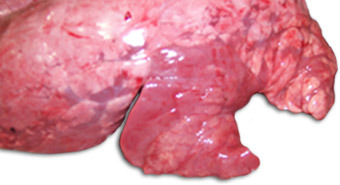Almost 50 years after being recognized as the causative agent of Enzootic Pneumonia, Mycoplasma hyopneumoniae (M. hyopneumoniae) still constitutes an important pathogen for the swine industry, to which it causes significant economic loses. The direct problem associated with M. hyopneumoniae infections is a chronic respiratory condition, which can be accompanied by a non-productive cough. Enzootic Pneumonia is usually presented as a high morbidity and low mortality situation, and profoundly affects the average daily gain and the feed conversion ratio in afflicted herds. Moreover, other key aspect of M. hyopneumoniae infections is the predisposition of the pigs to other respiratory diseases of bacterial and viral origin, which has been particularly crucial in the most recent decades after the emergence of porcine reproductive and respiratory virus, for example.
Infections with M. hyopneumoniae have been reported around the world throughout the years. Recent reports still show high prevalence of the pathogen in most pig producing countries. Also, it has been demonstrated that geographical zones previously considered M. hyopneumoniae free may no longer be considered as such, since the pathogen has been confirmed in members of their wild pig populations, thus posing a potential threat for domestic pigs.

Our knowledge about a number of features associated with M. hyopneumoniae and its infection in pigs has changed over time, and especially during the most recent years. The wide recognition of different degrees of virulence and the lack of clonality of M. hyopneumoniae strains may be the most mentioned ones. While the suspicion of variability of this bacterium was strong, the advent and availability of molecular tools for veterinary research and diagnostics has allowed for a more clear confirmation of the differences among M. hyopneumoniae strains. However, the potential implications of the genetic variability of this pathogen are just starting to be investigated, and it may be too early to conclude on the definite effect of different variants and their inherent properties at the field level.
Table 1. Mycoplasma hyopneumoniae strains can be classified based on the severity of disease observed in experimentally infected pigs.
 |
Virulence | Strain | Origin |
| Low | F13.7B | Europe | |
| Moderate | 232 | USA | |
| High | F7.2C | Europe |
Another aspect often heard in regards to contemporary infections with M. hyopneumoniae is a perceived higher difficulty to achieve control of clinical infections. Specifically, an apparent greater struggle has been observed in herds in which successful control programs were already in place. The exact reasons why these phenomena occur may not be attributable to a single cause, but rather to a myriad of factors that may have changed in the pathogen itself or in the way pigs are raised in modern times.
Several protocols have been developed for elimination of M. hyopneumoniae at herd, system, and even national level. Earlier attempts for elimination of this pathogen were especially designed for small farms and required a significant reduction of the herd size. Innovative strategies for M. hyopneumoniae elimination have been established by combining newer technologies and information gained from research and from other elimination programs.The most recent strategies now allow for eliminations to be carried out in farms of considerable size, and may not require a dramatic reduction of the reproductive herd while in the active elimination phase. Something that has been clearly identified is the production and economic advantage of growing M. hyopneumoniae negative pigs, and therefore the justified need to eliminate this pathogen in many production systems.
Table 2. Comparison of the most commonly applied M. hyopneumoniae elimination programs
| Method | Suitable for big size farms | Vaccine use | Antibiotic use | 14-day farrowing stop |
| Partial depopulation | No | No | Yes | Yes |
| Modified partial depopulation | Yes | Yes | Yes | Not in all cases |
In summary, infections with M. hyopneumoniae continue to be an important issue in swine around the globe, and high prevalence of the disease caused by pathogen is still reported in most pig producing areas. New challenges arise in the attempt to control infections with M. hyopneumoniae, as several aspects of the microorganism itself and the way it expresses in affected herds are recognized. However, the successful completion and over time maintenance of numerous elimination programs, has made M. hyopneumoniae elimination an achievable reality at all levels of pig production.






